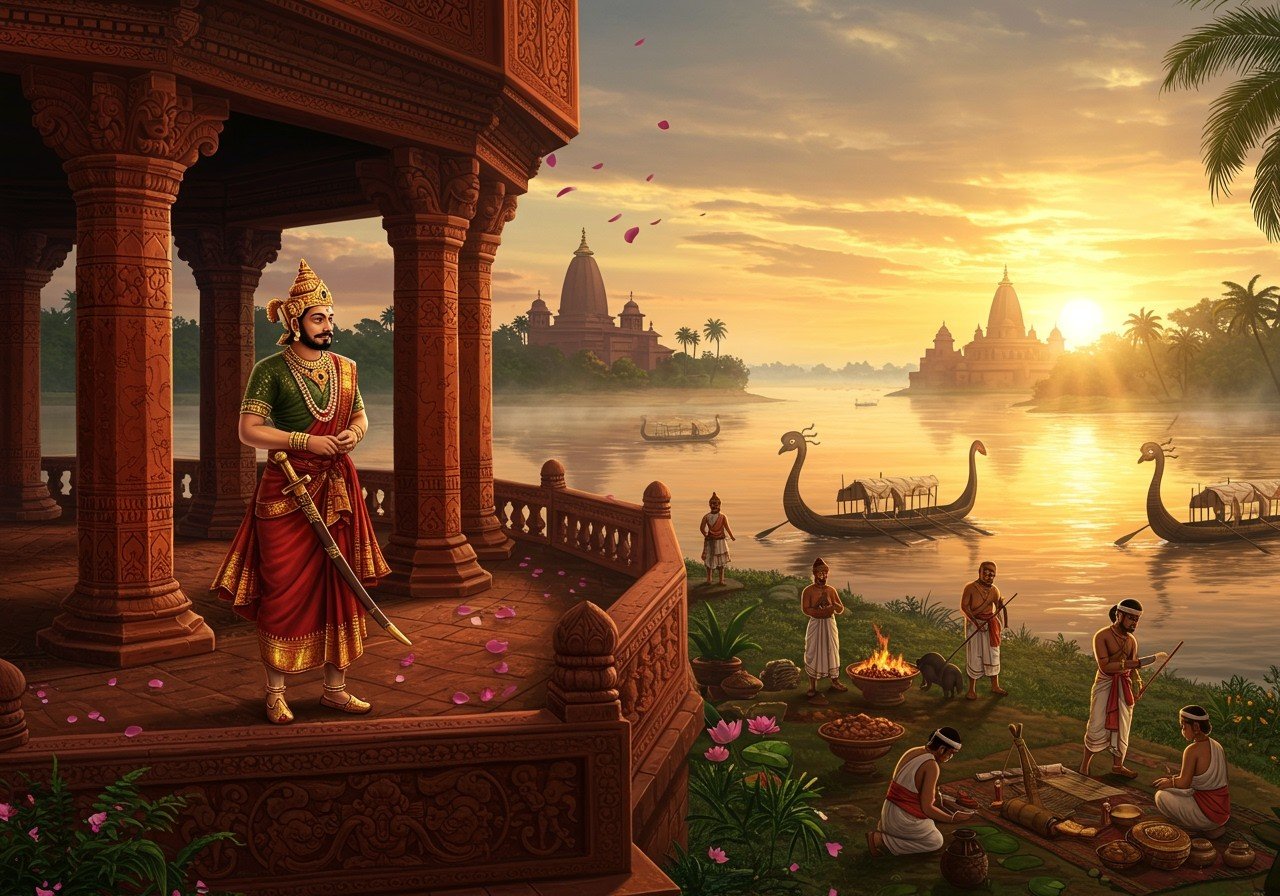
The Sukhrungphaa Dynasty, a glorious chapter in Assam’s history, is renowned for its political stability and cultural blossoming. Often referred to as a Golden Age within the Ahom Kingdom (1228-1826), this era profoundly shaped Assamese heritage and identity. Understanding the lineage of Ahom kings, particularly Sukhrungphaa (Rudra Singha), provides valuable insight into the kingdom’s expansion and its lasting influence on Assam’s cultural and historical landscape.
Historical Background of the Ahom Kingdom
The Ahom Kingdom’s Foundation: The Ahom Kingdom’s roots lie in the early 13th century with Sukaphaa’s arrival. Originating from present-day Yunnan, China, the Tai people migrated to the Brahmaputra Valley, establishing their presence through strategic alliances and diplomatic prowess. This allowed them to integrate with various local cultures, creating a unique blend.
The Ahoms displayed remarkable cultural adaptability, merging their own traditions with Assamese customs. This cultural fusion created a vibrant and dynamic society. Their innovative administrative systems, such as the Paik system for military and land organization, strengthened their governance. These foundations set the stage for a flourishing kingdom, which future leaders like Sukhrungphaa would inherit and expand upon.
The Reign of Sukhrungphaa (Rudra Singha)
A Visionary Leader: Sukhrungphaa, also known as Rudra Singha, ascended the throne with a transformative vision for Assam. His reign stands as a period of expansion and cultural richness. His ambition to elevate the kingdom was evident in both his military achievements and skillful diplomacy.
Sukhrungphaa’s military campaigns broadened the kingdom’s boundaries, securing Ahom dominance in the region. Beyond military strength, he nurtured a vibrant cultural atmosphere. As a patron of the arts, literature, and architecture, he fostered a flourishing creative landscape. Magnificent structures like Rang Ghar and Kareng Ghar, built during his time, embody the architectural splendor of the Ahom kingdom, serving as enduring symbols of its glory.
Champion of Religious Harmony: Sukhrungphaa’s reign fostered religious tolerance, contributing significantly to social unity. His support for diverse faiths encouraged peaceful coexistence among different communities, fostering stability and enabling cultural and economic prosperity.
Cultural and Economic Growth
A Cultural Renaissance: Under Sukhrungphaa’s guidance, Assam experienced a true cultural revival. Traditional Assamese arts, music, and literature flourished, enriching the cultural tapestry. This renaissance also extended to architecture, exemplified by the construction of grand structures like Rang Ghar, a royal sports pavilion, showcasing the era’s architectural achievements.
Economic Progress: Sukhrungphaa’s economic policies focused on enhancing agricultural output and expanding trade routes. Silk production emerged as a significant aspect of Assamese culture, with weaving traditions gaining prominence. This not only stimulated the economy but also reinforced a distinct cultural identity. Festivals and rituals played a vital role in maintaining social harmony and preserving cultural heritage, becoming integral to community life and reflecting the richness of the kingdom’s traditions.
The Enduring Legacy of the Sukhrungphaa Dynasty
Shaping Regional Identity: The impact of the Sukhrungphaa Dynasty continues to resonate in modern Assam. The administrative and cultural innovations introduced by the Ahoms have left an indelible mark on Assamese society. The preservation of Ahom traditions, rituals, and language stands as a powerful testament to their enduring heritage. Historical sites from this period serve as invaluable cultural treasures and draw tourists seeking a connection to the past.
Relevance in Historical Studies: The Sukhrungphaa Dynasty holds significant importance in academic research and historical discourse. Scholars continue to study this pivotal period to understand its profound influence on regional identity and cultural legacy. The kingdom’s story offers invaluable lessons in governance, cultural exchange, and adaptation.
Modern-Day Commemorations
Honoring Ahom Heritage: Modern Assam honors the legacy of the Sukhrungphaa Dynasty through festivals like Me-Dam-Me-Phi, a poignant tribute to Ahom ancestors. Cultural organizations and government bodies actively strive to preserve and promote Ahom heritage, ensuring its continued vitality.
Literature, film, and art play a crucial role in keeping the dynasty’s history alive for future generations, fostering pride and understanding. Educational programs further deepen our appreciation for this era’s significance, fostering a connection between past and present.
The Sukhrungphaa Dynasty shines as a beacon of Assam’s glorious past, reminding us of the strength of vision and unity. Through wise leadership, cultural patronage, and religious harmony, Sukhrungphaa shaped a thriving society. This era not only enriched Assamese culture but also forged a strong regional identity. As we celebrate this heritage through festivals, protect historical sites, and support educational initiatives, we uphold the values of tradition and progress. Sukhrungphaa’s contributions inspire us to cherish our rich history and embrace the future with pride and confidence.
How Poojn.in Helps Preserve Assamese Cultural Heritage
Poojn.in offers a wide selection of authentic puja items that connect you with Assam’s rich cultural heritage, especially from the time of the Sukhrungphaa Dynasty. Our carefully curated products help you uphold traditional Assamese customs and rituals. Looking to honor your heritage? We can help.
- Traditional Jewelry: Discover beautiful Sakha bangles in red and white (₹5.00 per piece) and other traditional holy jewelry that reflects Assamese cultural identity. Explore our collection of traditional jewelry.
- Puja Essentials: Find everything you need with our complete range of puja samagri, featuring over 186 authentic items. We also offer specialized pooja kits designed for specific Assamese rituals and holy utensils crafted with traditional designs. Browse our puja essentials.
- Sacred Items: We offer traditional holy idols, pure holy food items for religious ceremonies, and authentic clay items for various cultural practices. Everything is readily available for convenient online shopping and doorstep delivery. Find sacred items at Poojn.in.
Need help finding specific Assamese puja items? Reach out to us:
- Phone: 03369029784
- WhatsApp: 9476142738
Visit www.poojn.in to discover our complete collection of traditional Assamese puja items. (Please note: Prices may vary. Check our website for current pricing.)
Common Questions about the Sukhrungphaa Dynasty
What is the Sukhrungphaa Dynasty? The Sukhrungphaa Dynasty is another name for the Ahom Dynasty, which governed Assam for close to six centuries. This period is considered a golden age in the region’s history. It represents a significant part of the greater Ahom Kingdom’s timeline, which spanned from 1228 to 1826.
Who was Sukhrungphaa? Sukhrungphaa, also known as Rudra Singha, was a prominent Ahom king celebrated for his contributions to culture and architecture. He ruled during a time of prosperity and expansion within the larger context of the Ahom Kingdom.
Why is this era called Assam’s Golden Age? This period is referred to as Assam’s Golden Age because of the prosperity, cultural growth, and lasting peace it brought to the region. It stands out within the longer history of the Ahom Kingdom (1228-1826) as a time of notable achievement.
What were some key achievements of this dynasty? The Sukhrungphaa Dynasty, within the larger Ahom Kingdom era, is known for its robust administration, military victories, and patronage of art and culture. These achievements significantly contributed to the region’s development.
How did the dynasty maintain power for so long? The dynasty maintained power through strategic military campaigns, alliances, and efficient governance, factors that contributed to the Ahom Kingdom’s longevity from 1228 to 1826.
What role did the dynasty play in Assam’s history? The Sukhrungphaa Dynasty played a pivotal role by unifying the region and fostering a period of economic and cultural progress within the larger context of the Ahom Kingdom (1228-1826).
Are there any notable monuments from this period? Yes, structures like Talatal Ghar and Rang Ghar are well-known monuments from this era of the Ahom Kingdom. They provide a glimpse into the architectural achievements of the time.
How did the dynasty eventually come to an end? The dynasty eventually declined due to internal disputes and external pressure from the British Empire, marking the end of this chapter within the Ahom Kingdom’s history, which concluded in 1826.
Want to delve deeper into the fascinating history of Assam? You can discover more about the historical context, rituals, and cultural significance of Dhekiakhowa Bornamghar by exploring these related articles:
- Dhekiakhowa Bornamghar: A Journey Through Time
- Dhekiakhowa Bornamghar: Assam’s Spiritual Heart
- Dhekiakhowa Bornamghar: Rituals and Practices Explained
- Assam’s Sacred Sites: Ugratara Devalaya and Other Spiritual Journeys


